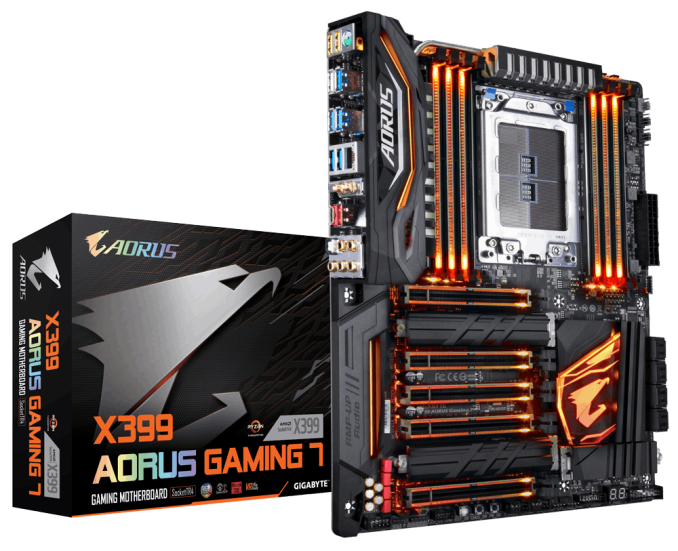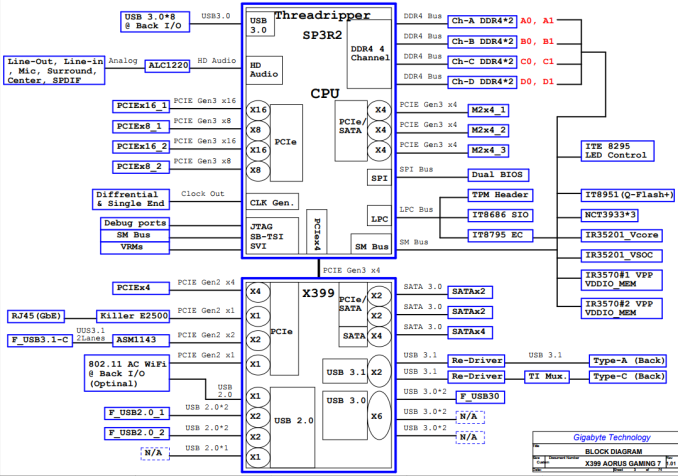An AMD Threadripper X399 Motherboard Overview: A Quick Look at Seven Products
by Ian Cutress & Joe Shields on September 15, 2017 9:00 AM ESTGIGABYTE
GIGABYTE's initial entry into the Threadripper platform is the X399 AORUS Gaming 7, formally placing the name AORUS into the motherboard listing. In GIGABYTE’s typical product stack of Gaming X versions, models usually have a 3, a 5, a 7 or a 9 at the end. With this one being a Gaming 7, it stands to reason that GIGABYTE might have something for the more extreme Threadripper audience in a future Gaming 9, or a product easier on the wallet in a future Gaming 3. For now, the X399 AORUS Gaming 7 stands alone, although the specifications ensure that it is one of the higher-end products at launch.
Edit: We've been informed that GIGABYTE has an X399 Designare on the way!
X399 AORUS Gaming 7
If the promotional shots are anything to go buy, GIGABYTE is adamant that you must know that the motherboard has RGB LEDs, and it has them almost everywhere. Between the DRAM slots, on all the PCIe slots, through a transparent plastic shield on the chipset heatsink, on the audio shield, and on the IO cover. If you thought RGB was kitsch, then the Gaming 7 is a one way ticket to kitsch central.
As with the other boards in this roundup, quad channel memory at two DIMMs per channel is the name of the game for the socket area, and similarly we get a power delivery system that uses a main heatsink connected to a secondary heatsink by the rear IO via a heatpipe, but carefully hidden under the rear IO vanity plate. In a plus point to marketing, GIGABYTE is listing its power delivery as ‘server class’, using fourth generation International Rectifier (IR) PWM controllers and third generation PowIRstage chokes. The EPS connectors for the power delivery are found in the top left corner of the board, with one 8-pin and one 4-pin.
On the top right of the board is an array of five 4-pin fan headers, paired with an RGBW header marking GIGABYTE’s different approach to added RGB LED connectivity. There other 4-pin fan headers on board, with at least two on the bottom, again with another RGBW header. Speaking of headers, USB connectivity comes through an onboard USB 3.1 (10 Gbps) header from the chipset near the eight SATA ports, a USB 3.0 header on the bottom of the board, two USB 2.0 headers near the power buttons also on the bottom of the board, and a TPM header.
One of the headline features on the Gaming 7 is the support for three M.2 drives, as shown in the image above. The two areas for M.2 drives between the PCIe slots support 110mm long drives, while the area below the heatsink supports a more standard 80mm drive. All three of these M.2 slots come with additional heatsinks, providing a better thermal environment for any drive and not disturbing the aesthetic of the system. Compared to other motherboards, GIGABYTE has implemented this arrangement rather than pursue a separate (or switched) U.2 connector. For other storage, GIGABYTE has equipped the board with eight SATA ports.
The PCIe slot arrangement, despite having every slot with additional RGB and slot reinforcement, only four of these slots are direct from the CPU for peak graphics duty. The slots that are doubly spaced support an x16/x8/x16/x8 arrangement, with the middle slot supporting a separate PCIe 3.0 x4 connection through the chipset. The idea is that the middle slot can be used for an add-in card, such as 10 gigabit Ethernet or additional connectivity while using two GPUs.
Next to the PCIe slots is GIGABYTE’s audio solution, using the Realtek ALC1220 audio codec and implementing an EMI shield, PCB separation for digital and analog signals, filter caps and headphone jack detection. GIGABYTE also likes to promote DAC-UP, ensuring a more consistent USB power delivery port for USB connected audio devices. It’s not necessarily a unique feature, although it rarely gets marketing attention on other motherboards.
Connectivity on the rear IO panel shows one of the few motherboards with a PS/2 port, which can be useful in some environments. Due to the support for USB 3.0 from the CPU, the rear panel has a full set of eight USB 3.0 ports, in yellow, blue and a white color. There is also two USB 3.1 (10 Gbps) ports from the chipset, one of which is USB Type-C. Network connectivity is provided by a Rivet Networks Killer E2500 and a WiFi solution, and at the end are a set of audio jacks.
GIGABYTE supplied a chipset/block diagram as well to show the lane routing on the Gaming 7:
| GIGABYTE X399 AORUS Gaming 7 | |
| Warranty Period | 3 Years |
| Product Page | Link |
| Price | $389.99 |
| Size | ATX |
| CPU Interface | TR4 |
| Chipset | AMD X399 |
| Memory Slots (DDR4) | Eight DDR4 Supporting 128GB Quad Channel Support DDR4 3600+ Support for ECC UDIMM (operates in non-ECC mode) |
| Network Connectivity | 1 x Rivet Networks Killer E2500 LAN 1 x Intel 2x2 802.11ac |
| Onboard Audio | Realtek ALC1220 |
| PCIe Slots for Graphics (from CPU) | 2 x PCIe 3.0 x16 slots @ x16 2 x PCIe 3.0 x16 slots @ x8 |
| PCIe Slots for Other (from Chipset) | 1 x PCIe 2.0 x16 slots @ x4 (PCIeX4) |
| Onboard SATA | 8 x Supporting RAID 0/1/10 |
| Onboard SATA Express | None |
| Onboard M.2 | 3 x PCIe 3.0 x4 - NVMe or SATA |
| Onboard U.2 | None |
| USB 3.1 | 1 x Type-C (ASMedia) 1 x Type-A (ASMedia) |
| USB 3.0 | 8 x Back Panel 1 x Header |
| USB 2.0 | 2 x Headers |
| Power Connectors | 1 x 24-pin EATX 1 x 8-pin ATX 12V 1 x 4-pin ATX 12V |
| Fan Headers | 1 x CPU 1 x Watercooling CPU 4 x System Fan headers 2 x System Fan/ Water Pump headers |
| IO Panel | 1 x PS.2 keyboard/mouse port 1 x USB 3.1 Type-C 1 x USB 3.1 Type-A 8 x USB 3.0 1 x RJ-45 LAN Port 1 x Optical S/PDIF out 5 x Audio Jacks Antenna connectors |



















99 Comments
View All Comments
LordanSS - Saturday, September 16, 2017 - link
My money is on the latter.... =/vgray35@hotmail.com - Friday, September 15, 2017 - link
With CPU power approaching 150 Amps, all these MBs are brain dead right out the gate, for using 50y old 8+ phase Buck converter topology, where VRMs with multiple phases still have poor response settling times (not one cycle settling but 20 cycles), lowish efficiencies way below 98% needing substantial heat sinks; while being saddled with the vagaries of inductive energy storage which takes up a lot of space and cost much more. Instead they should be using hybrid-PWM switching eliminating hard switch of high currents, where fractional cycle resonance ensures zero current switching and almost no switching losses. Resonance frequency scaling of the inductor/capacitor eliminates the need for ferrite cores altogether, reducing both size and core losses.http://www.powerelectronics.com/power-management/s...
Rehashing the same old power technologies with only stepwise minuscule improvements at each iteration, is not going to bode well at all. These engineers need to join the rest of us in the 21st century, and stop rehashing inductive energy storage solutions in power supplies. These new power topologies have been available for 5y to 8y now. And further this will also reduce EMI noise.
vgray35@hotmail.com - Friday, September 15, 2017 - link
I might add eliminating the multi-phase Buck converters for a solution based on PWM-resonance switching (hybrid switching), fractional cycle resonance (one cycle settling responses), and resonance scaling of resonance components, will likely permit a X399 mITX board to be made; with all that PSU space recovered for other purposes. Who will take up the challenge? AMD, ASROCK? Or will Intel beat AMD in the rush to high current capability at 99% efficiency? Or one of the other competitors out there! A clarion call to action this is to once and for all retire the Buck converter!ddriver - Friday, September 15, 2017 - link
I doubt they will even make a micro atx board, much less itx...It will be a waste, gigantic socket will take up most of the space, there won't be enough room for all 4 memory channels, the CPUs generous amount of PCIE lanes will be utterly wasted.
vgray35@hotmail.com - Friday, September 15, 2017 - link
Yes, and yet ASROCK put the X99 on a mITX board. However cutting heat from the VRM's by 60% to 70% or more should be done anyway, not to mention the graphics cards that draw even more power. Why settle for 95/96% efficiency (or worse in some cases) when one could get 98.5% to 99% efficiency. But then again you might be right concerning Thread Ripper, although I would still buy it with M2 slots on the back. The power delivery could be moved entirely to the back of the board without heat sinks with a total height of only 1.5mm (possibly at the center of socket itself on the back). The challenge of course is just as applicable to the graphics cards.ddriver - Saturday, September 16, 2017 - link
Hm, it seems that they launched some lga2066 boards recently, an asrock itx and an msi matx. TR4 however is still atx and up only...DanNeely - Friday, September 15, 2017 - link
I agree about how little sense it would make; but there have been a few LGA2011 mITX boards for people who only needed the higher core count. One of the two currently listed on Newegg uses SoDIMMs and riser boards around the CPU socket to make everything fit. Doing it for Threadripper would definitely be harder on account of the bigger socket; but I won't say never.Xajel - Saturday, September 16, 2017 - link
mITX is very hard even with riser boards & only 4x SO-DIMMsbut mATX on the other hand is very plausible... lets hope for a mATX version of the ASRock Pro Gaming with it's 10GbE ( and at least one of it's Intel's 1GbE ), at least 2 of it's M.2's and 6+ SATA ports... and please ASRock, add a front USB 3.1g2 header...
ddriver - Friday, September 15, 2017 - link
Amps, or amperes, is a unit of current, not a unit of power. Power is measured in watts."Rehashing the same old power technologies with only stepwise minuscule improvements at each iteration, is not going to bode well at all." - this is unfortunately a fact, and the de-fact motto of the industry.
ddriver - Friday, September 15, 2017 - link
I mean it is kinda naive to assume several years old switching circuits will find their way into the mainstream just because they are a few percent better.We've had gas turbine engines for decades, but they are still only used in tanks, helicopters or naval ships, while mainstream vehicles are still stuck with the internal combustion engine, which is easier to break, harder to maintain and a whooping 60% less efficient.